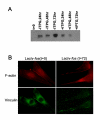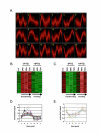A transcriptome map of cellular transformation by the fos oncogene
- PMID: 15918904
- PMCID: PMC1177986
- DOI: 10.1186/1476-4598-4-19
A transcriptome map of cellular transformation by the fos oncogene
Abstract
Background: The c-fos gene was originally identified as the cellular homolog of the oncogene v-fos carried by the Finkel-Biskis-Jenkins and Finkel-Biskis-Reilly murine osteogenic sarcoma retroviruses. Sustained expression of fos is sufficient to induce cellular transformation in vitro and tumorigenesis in vivo. Fos functions as a component of the AP-1 transcription factor complex to regulate gene transcription and several differentially expressed genes have been identified in cells transformed by fos. We have extended these studies by constructing a cellular system for conditional transformation by v-fos. Using Affymetrix-based DNA microarray technology, we analyzed transcriptional changes over the course of transformation and reversion in an inducible v-fos system.
Results: Microarray analyses of temporal gene expression during the process of v-fos mediated cellular transformation and morphological reversion revealed a remarkably dynamic transcriptome. Of the more than 8000 genes analyzed in this study, 3766 genes were categorized into 18 gene-expression patterns by using self-organizing map analysis. By combining the analysis of gene expression profiles in stably transformed cells with the analysis of sequential expression patterns during conditional transformation, we identified a relatively small cohort of genes implicated in v-fos mediated cellular transformation.
Conclusion: This approach defines a general conditional cell transformation system that can be used to study the endogenous transcription regulatory mechanisms involved in transformation and tumorigenesis. In addition, this study is the first reported analysis of dynamic changes in gene expression throughout experimentally controlled morphological transformation mediated by v-fos.
Figures




Similar articles
-
Multiple regions of v-Fos protein involved in the activation of AP1-dependent transcription: is trans-activation crucial for transformation?New Biol. 1991 Jul;3(7):671-7. New Biol. 1991. PMID: 1751449
-
B-ATF functions as a negative regulator of AP-1 mediated transcription and blocks cellular transformation by Ras and Fos.Oncogene. 2000 Mar 30;19(14):1752-63. doi: 10.1038/sj.onc.1203491. Oncogene. 2000. PMID: 10777209
-
Use of revertant cell lines to identify targets of v-fos transformation-specific alterations in gene expression.Cell Growth Differ. 1990 Dec;1(12):581-90. Cell Growth Differ. 1990. PMID: 2126949
-
Decreased susceptibility to calpains of v-FosFBR but not of v-FosFBJ or v-JunASV17 retroviral proteins compared with their cellular counterparts.Biochem J. 1997 May 1;323 ( Pt 3)(Pt 3):685-92. doi: 10.1042/bj3230685. Biochem J. 1997. PMID: 9169601 Free PMC article.
-
Functional in vitro assays for the isolation of cell transformation effector and suppressor genes.Environ Health Perspect. 1991 Jun;93:83-9. doi: 10.1289/ehp.919383. Environ Health Perspect. 1991. PMID: 1685446 Free PMC article. Review.
Cited by
-
Differential Wnt-β- catenin pathway activation in HPV positive and negative oral epithelium is transmitted during head and neck tumorigenesis: clinical implications.Med Microbiol Immunol. 2021 Feb;210(1):49-63. doi: 10.1007/s00430-020-00697-9. Epub 2020 Nov 23. Med Microbiol Immunol. 2021. PMID: 33226516
-
A novel class of interstitial cells in the mouse and monkey female reproductive tracts.Biol Reprod. 2015 Apr;92(4):102. doi: 10.1095/biolreprod.114.124388. Epub 2015 Mar 18. Biol Reprod. 2015. PMID: 25788664 Free PMC article.
-
AP-1 differentially expressed proteins Krp1 and fibronectin cooperatively enhance Rho-ROCK-independent mesenchymal invasion by altering the function, localization, and activity of nondifferentially expressed proteins.Mol Cell Biol. 2006 Feb;26(4):1480-95. doi: 10.1128/MCB.26.4.1480-1495.2006. Mol Cell Biol. 2006. PMID: 16449658 Free PMC article.
-
O6-methylguanine-DNA methyltransferase is downregulated in transformed astrocyte cells: implications for anti-glioma therapies.Mol Cancer. 2007 Jun 5;6:36. doi: 10.1186/1476-4598-6-36. Mol Cancer. 2007. PMID: 17547775 Free PMC article.
-
Viral oncoproteins target the DNA methyltransferases.Oncogene. 2007 Mar 8;26(11):1650-5. doi: 10.1038/sj.onc.1209950. Epub 2006 Sep 18. Oncogene. 2007. PMID: 16983344 Free PMC article.
References
-
- Curran T. The fos oncogene. In: Reddy EP, Shalka AM, Curran T, editor. The oncogene handbook. Amsterdam: Elsevier; 1988. pp. 307–325.
-
- Finkel MP, Biskis BO, Jinkins PB. Virus induction of osteosarcomas in mice. Science. 1966;151:698–701. - PubMed
Publication types
MeSH terms
Substances
Grants and funding
LinkOut - more resources
Full Text Sources

